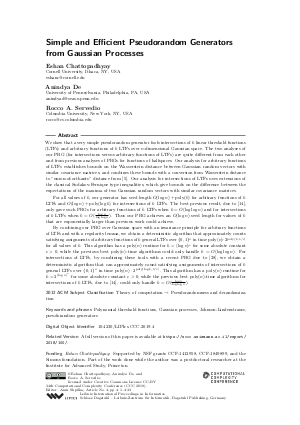@InProceedings{chattopadhyay_et_al:LIPIcs.CCC.2019.4,
author = {Chattopadhyay, Eshan and De, Anindya and Servedio, Rocco A.},
title = {{Simple and Efficient Pseudorandom Generators from Gaussian Processes}},
booktitle = {34th Computational Complexity Conference (CCC 2019)},
pages = {4:1--4:33},
series = {Leibniz International Proceedings in Informatics (LIPIcs)},
ISBN = {978-3-95977-116-0},
ISSN = {1868-8969},
year = {2019},
volume = {137},
editor = {Shpilka, Amir},
publisher = {Schloss Dagstuhl -- Leibniz-Zentrum f{\"u}r Informatik},
address = {Dagstuhl, Germany},
URL = {https://drops.dagstuhl.de/entities/document/10.4230/LIPIcs.CCC.2019.4},
URN = {urn:nbn:de:0030-drops-108262},
doi = {10.4230/LIPIcs.CCC.2019.4},
annote = {Keywords: Polynomial threshold functions, Gaussian processes, Johnson-Lindenstrauss, pseudorandom generators}
}

 Creative Commons Attribution 3.0 Unported license
Creative Commons Attribution 3.0 Unported license





























